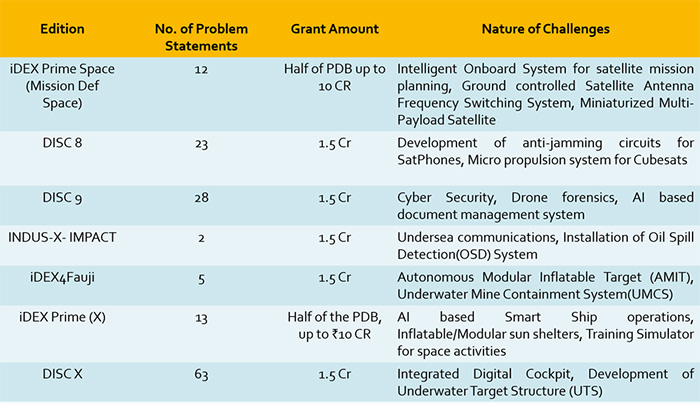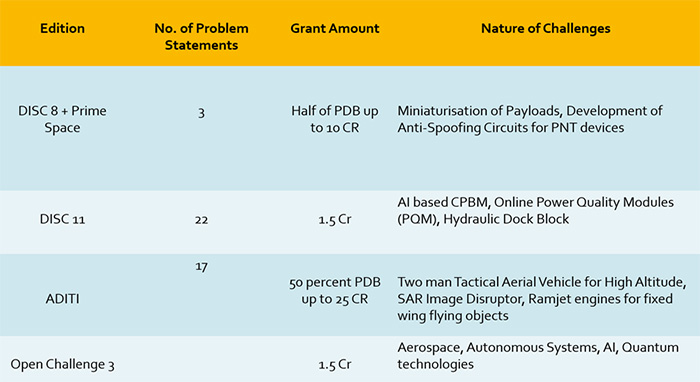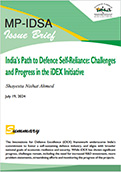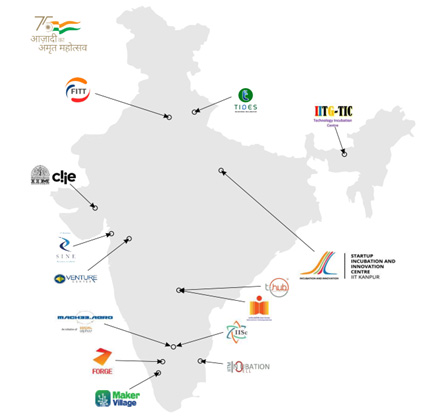You are here
India’s Path to Defence Self-Reliance: Challenges and Progress in the iDEX Initiative
Summary
The Innovations for Defence Excellence (iDEX) framework underscores India’s commitment to foster a self-sustaining defence industry, and aligns with broader national goals of economic resilience and security. While iDEX has shown significant progress, challenges remain, including the need for increased R&D investment, more problem statements, streamlining efforts and monitoring the progress of the projects.
Introduction
India’s pursuit of self-reliance and indigenous development in the defence sector is essential for achieving strategic autonomy. Significant progress has been made towards indigenous defence production through various government initiatives that integrate public support and private sector leadership. India, however, remains the largest importer of defence equipment, accounting for approximately 9.8 per cent of global imports from 2019 to 2023.1 In recent years, India has increased plans for indigenisation and modernisation of its defence and strategic systems and sub-systems, focusing on import substitution and the development of MSMEs and SMEs through indigenisation programmes. Various initiatives and reform measures have been implemented to “encourage indigenous design, development, and manufacture of defence equipment, thereby promoting self-reliance in defence manufacturing and technology in the country”.2
To focus national efforts on indigenisation and R&D in defence technology, the Innovations for Defence Excellence (iDEX) framework was approved by the Ministry of Defence (MoD) through the Department of Defence Production (DDP), in collaboration with Start Up India and the Atal Innovation Mission (AIM). iDEX aims to encourage self-reliance and indigenisation in the defence and aerospace sectors, in line with the government’s ‘Atmanirbhar Bharat Abhiyan’. Launched by Prime Minister Narendra Modi during the 10th DefExpo on 12 April 2018, in Chennai, Tamil Nadu, iDEX engages start-ups to address defence production challenges, pioneer essential new technologies for the defence forces, and reduce reliance on imported technology.3
Background
Amid the COVID-19 crisis, the call for aatmanirbharta emerged to achieve self-reliance, efficiency and resilience across all economic sectors. The push for self-reliance in the defence sector was driven not just by the desire to reduce import dependency, but also to establish India as a global defence exporter. Prime Minister Narendra Modi, during the MoD’s post-budget ‘Webinar on Budget Announcements: 2022-23 Aatmanirbharta in Defence – Call to Action’ on 25 February 2022, emphasised the importance of self-reliance, particularly in creating tailored military hardware and systems to address various levels of adversarial threats.4
The Defence Acquisition Procedure (DAP-2020) Chapter III, known as the ‘Make Procedure’, aims to enhance the Indian defence industry’s involvement in designing and developing defence equipment.5 This initiative aims to promote research and development, previously dominated by DRDO and DPSUs, by simplifying and expanding the ‘Make’ guidelines. Additionally, two innovation-focused schemes have been launched—iDEX, which targets projects from start-ups and MSMEs with high innovation potential despite low capital investment, and the ‘Technology Development Fund’ (TDF), which enables DRDO to harness domestic capabilities, particularly from MSMEs and start-ups.6 Moreover, DRDO’s ‘Dare to Dream Innovation’ contest supports start-ups and fosters innovation in the defence sector.7
The objectives of the iDEX initiative are multifaceted. It primarily seeks to expedite the advancement of innovative and home-grown technologies tailored for the Indian defence and aerospace domains, addressing their requirements within tighter timeframes.8 Secondly, it aims to foster a collaborative environment with pioneering start-ups, promoting joint creation initiatives for defence and aerospace industry. Thirdly, it endeavours to cultivate a climate conducive to technological collaboration and joint innovation within these sectors. iDEX also aims to invigorate innovation within start-up ventures and foster their integration into the broader Indian defence and aerospace ecosystem.
The DDP channels funding to the Defence Innovation Organisation (DIO) for implementing the iDEX scheme, focus on three key functions: co-innovation, piloting technologies, and indigenising defence and aerospace platforms through Transfer of Technologies (ToTs).9 As the operational arm of DIO, the iDEX structure collaborates with relevant stakeholders to oversee these functions. It establishes and manages Independent Defence Innovation Hubs (DIHs) as Partner Incubators (PIs), hosting challenges and hackathons to identify promising technologies and assessing their impact on Indian defence.
iDEX evaluates innovations, funds pilot projects, coordinates with military leadership, and facilitates scaling and indigenisation efforts. The initiative aims to cultivate ongoing collaboration between innovators and the defence industry, fostering a culture of innovation within the military.10 Partner Incubators provide extensive support to iDEX winners, including mentoring and running accelerator programmes to enhance capabilities of selected start-ups and MSMEs. They also engage in outreach activities to promote defence innovation among students and researchers at all academic levels.
Facilitation of Defence Innovation Funds to Steer Innovation
As the executive arm of the Defence Innovation Organisation (DIO), iDEX executes necessary activities while DIO provides policy guidance. It was established as a Section 8 company under the Companies Act 2013 Non-Profit Organisation (NPO) to facilitate the creation of an ecosystem for innovation and technology development in the fields of defence and aerospace. The DIO was established with initial funding from its founding members, HAL and BEL, amounting to Rs 100 crores. The DIO, with its iDEX team, collaborates with SHQs (Service Headquarters), DPSUs, partner incubators and DIHs, under the direction of the DIO board regarding the use of Defence Innovation Funds (DIF).11
Apart from the funding by HAL and BEL, contributions of 2 per cent of net profits from other DPSUs such as such as BEML, BDL, MIDHANI, MDL, GRSE, GSL and HSL, 25 per cent of CSR funds from DPSUs, support for dual-application products, and additional funds from the Ministry of Defence as needed12 form the bulk of the funds available to the iDEX. The scheme has been granted a budgetary support of Rs 498.8 crore for the period 2021–22 to 2025–26 to provide financial assistance to around 300 MSMEs and start-ups and about 20 partner incubators through the DIO framework.13 Figure 1 shows where these incubators are located.
iDEX provides grants up to Rs 1.50 Cr (up to Rs 10 Cr for iDEX Prime) to start-ups and MSMEs for projects in various technological areas under the Defence India Start-up Challenges (DISC) and Open Challenge through the Support for Prototype and Research Kickstart (SPARK) Framework. The SPARK framework assists in developing functional prototypes for products and technologies crucial to national security and accelerates innovation within the Indian defence sector by facilitating market identification and commercialisation within the Indian defence establishment. Its functions include research and development, prototyping, pilot implementation and market assessment. The technological challenges are referred to as Problem Statements (PS) and are taken up by the DISC challenges from the armed forces and DPSUs.14
During the Aero-India 2023, Defence Minister Rajnath Singh launched the iDEX Innovators Hub (IIH) to boost investments in the defence sector, with Rs 200 crore committed by nine prominent investors to support the growth of the start-up ecosystem.15 IIH aims to provide investors with a unified view of opportunities and innovations in the defence sector, emphasising skill development, investor access, mentoring and technology showcasing to attract investment.16 DIHs and IIHs play complementary roles in fostering defence sector innovation.
IIHs, established under the iDEX initiative, collaborate with Partner Incubators nationwide to identify, nurture and scale innovative technologies from start-ups and MSMEs focused on defence applications. On the other hand, DIHs serve as expansive platforms encompassing defence research organisations, industry, academia and start-ups. They facilitate collaborative R&D, technology transfer and indigenisation efforts, aligning with national defence policies to bolster technological capabilities and reduce reliance on imported equipment. Together, IIHs and DIHs create a cohesive ecosystem where start-ups and established entities collaborate to address defence technology challenges comprehensively.17
The intellectual property rights (IPR) developed within the company, institution, or by individual innovators will belong to the start-up or MSME entity. However, the government retains the right to impose Government Purpose Rights (GPRs) for internal use or manufacturing, and can exercise March-In Rights to take over patents in the interest of national security if certain conditions are not met by the rights holder.18 Additionally, Ministry of Defence (MoD) export control regulations apply to technology or product exports resulting from the project. Entities receiving grants under this scheme must maintain proper accounts and submit Utilisation Certificates.19 These documents will be subject to verification or audit by an agency appointed by the Defence Innovation Organisation (DIO).
Sub-schemes within iDEX Framework
Several sub-schemes have been launched to meet the technological needs of the armed forces and DPSUs. Figure 2 and Table 1 detail the various sub-schemes that have been implemented.

Source: Author
Table 1: iDEX Scheme Details
|
Scheme Name |
Date of Launch |
Fund |
Scope |
|
iDEX |
April 2018 |
Up to 1.5 Cr on milestone basis |
Prototype development and Commercialisation |
|
iDEX Prime and Prime –X |
20 December 2023 |
Half of PDB up to 10 Cr |
To support projects beyond 1.5 Cr up to 10 Cr |
|
Mission DefSpace |
2 January 2023 |
Half of PDB up to 10 Cr |
Technologies in every stage of Space mission (Mission Planning to Satellite Data Analytics |
|
iDEX4Faujis |
20 December 2023 |
Up to 1.5 Cr |
To support innovations by members of Armed Forces in existing platforms and equipment, and create futuristic innovations in defence |
|
iDEX SPRINT |
18 July 2022 |
Half of PDB up to 10 Cr |
To boost the usage of indigenous technology in the Indian Navy during Naval Innovation and Indigenisation (NIIO) Seminar, Swavlamban |
|
INDUS-X Mutual Promotion of Advanced Collaborative Technologies (IMPACT) |
30 November 2023 |
1.5 Cr |
Promoting co-development among start-ups of the 2 states (iDex + US DoD – Defence Innovation Unit) |
|
ADITI |
4 March 2024 |
50% of PDB Up to 25 Cr |
30 critical and advanced technologies with defence applications having export potential |
Source: PIB Reports
The Problem Statements (PS) within the iDEX framework have been directed towards fostering innovation and technological advancement which offers up to Rs 1.5 crore for prototype development and commercialisation. The iDEX Prime and Prime-X, launched on 20 December 2023, supports larger projects with funding up to Rs 10 crore.20 In this respect, 50 per cent of the Product Development Budget (PDB) is to be brought from the start-up side. Mission DefSpace, started on 2 January 2023, focuses on space technologies across various stages of a mission, and the budget is up to Rs 10 crore.21
Launched on the same day as iDEX Prime, iDEX4Faujis aims to support armed forces' innovations up to Rs 1.5 crore.22 The iDEX SPRINT initiative, started on 18 July 2022, promotes indigenous technology in the Navy with funding up to Rs 10 crore.23 The INDUS-X IMPACT, from 30 November 2023, encourages collaborative tech development between Indian and US start-ups with up to Rs 1.5 crore.24
Lastly, ADITI, launched on 4 March 2024, targets the development of critical defence technologies with a budget of up to Rs 25 crore.25 This particular scheme has a budget of Rs 750 crore spanning from 2023–24 to 2025–26 and it aims to promote innovation in critical and strategic defence technologies. Under this scheme, grants can cover up to 50 per cent of the Product Development Budget (PDB), with a maximum limit of Rs 25 crore.26 Additionally, a Technology Watch Tool has been introduced as a corollary feature to align armed forces’ requirements with defence innovation capabilities, ensuring no duplication of technologies.27 Table 2 provides the number of iDEX problem statements against different challenges.



Source: PIB Reports
Progress and Milestones in iDEX Initiatives
There has been significant progress with the initiation and the coming of shape of multiple iDEX schemes. The iDEX initiative has successfully engaged over 300 start-ups and MSMEs, encouraging them to develop cutting-edge technologies for defence applications. This engagement has helped in identifying and nurturing innovative solutions tailored to the needs of the Indian armed forces.28 Several start-ups supported by iDEX have also successfully developed and demonstrated prototypes that have the potential to be integrated into the defence ecosystem.
The Indian Army has made a notable advancement in promoting innovation and technological development in defence and aerospace by issuing its first-ever procurement order under the initiative. On 14 March 2023, the contract was awarded to the Indian start-up Hyper Stealth Technologies Private Limited for the procurement of an indigenously developed ‘Integrated Mobile Camouflage System (IMCS)’ for Mechanised Forces.29
Furthermore, Big Bang Boom Solutions Pvt Ltd (BBBS), a start-up in the defence sector, has landed a substantial contract exceeding Rs 200 crores from the Indian Air Force and Indian Army for its advanced anti-drone technology. This landmark deal is the largest under the initiative and one of the most significant contracts signed by the Ministry of Defence with an Indian start-up.30
Moreover, during the financial year 2022–23, investments in drone start-ups in India doubled from 50 million dollars, compared to 25 million dollars in 2021–22.31 Former Chief of Army Staff General Manoj Pande mentioned at the Maharashtra MSME Defence Expo 2024 that the Indian Army is advancing 55 projects worth Rs 400 crore through the iDEX route, involving 65 start-ups. Additionally, four contracts worth Rs 70 crore have been finalised for limited procurement of equipment for field exploitation.32
In addition to iDEX, emulating successful initiatives like the Meher Baba competition across different branches of the military can foster innovation and technological advancements, as seen in the aerospace and drone industry.33 Moreover, on 25 June 2024, iDEX signed its 350th contract with SpacePixxel Technologies Pvt Ltd to develop a miniaturised satellite capable of carrying multiple advanced payloads, marking a significant innovation in space electronics with benefits like faster deployment, cost efficiency and reduced environmental impact.34
Limitations in iDEX Mechanism
Despite covering extensive ground to promote defence indigenisation efforts, there remain certain limitations in the iDEX mechanism.
- Possibility of Duplication of Efforts: Efforts to streamline indigenisation and innovation between DRDO’s TDF scheme and the iDEX scheme by the DIO are necessary to avoid duplicating efforts in developing advanced technology capabilities for defence applications. The quantity and timelines for procurement from iDEX competition winners are undefined, hampering the transformation of innovative prototypes into finished products and commercialisation. Consequently, winners struggle with high development costs and delays in procurement by their sole buyer, the defence establishment.35
- Need for Expansion of INDUS- X-IMPACT Challenges: INDUS-X needs to maintain momentum and expand its scope. Key progress areas include increasing the number of joint innovation challenges and creating a clear roadmap to help private entities anticipate commercial demand. Clarity on procurement rules, establishing a joint project facilitation team, and enhancing R&D testing and evaluation in India are essential.36 Further collaboration can be achieved by sharing standards, signing an International Armament Cooperation (IAC) agreement, and responsibly developing AI and automation technologies.37 Establishing a joint innovation fund and accelerator programme, along with mobilising talent through exchange programmes and fellowships, will also be crucial for growth in this area.
- Funding and Development Challenges: Start-ups need to provide 50 per cent of their PDB themselves and need support for gaining market exposure and securing future orders for their prototypes. The funding cap of up to Rs 25 crore can be limiting, particularly for hardware prototype development.38 To address this issue, the development and manufacturing of larger and more niche components maybe handled by other schemes within the defence innovation ecosystem.
In conclusion, the iDEX initiative has made commendable progress in building a robust defence innovation ecosystem in India, fostering self-reliance and reducing dependence on imported technologies. It represents a pivotal initiative towards achieving self-reliance in defence technology, aligning with the broader goal of promoting indigenous innovation and bolstering India’s defence capabilities.
Nevertheless, the Indian defence ecosystem lacks robust research and development mechanism, resulting in heavy reliance on imported components. India allocates a modest 0.64 per cent of its GDP to R&D, lagging behind countries like China (2.4 per cent), Germany (3.1 per cent), South Korea (4.8 per cent), and the US (3.5 per cent).39 To optimise India’s R&D landscape and for fostering sustainable growth and innovation, it is crucial to address challenges such as equitable fund distribution, promoting interdisciplinary collaborations and upholding international standards.
Moreover, establishing realistic timelines for import bans through successive positive indigenisation lists, enhancing testing facilities, offering financial assistance to start-ups, and facilitating access to technology can streamline India’s efforts in promoting indigenous defence manufacturing. The coordinated efforts of various stakeholders, coupled with effective oversight mechanisms, are essential for the successful implementation of such schemes, ultimately contributing to national security and economic growth.
Views expressed are of the author and do not necessarily reflect the views of the Manohar Parrikar IDSA or of the Government of India.
- 1. Pieter D. Wezeman et al., “Trends in International Arms Transfers, 2023”, SIPRI Fact Sheet, Stockholm International Peace Research Institute, March 2024.
- 2. “Make-in-India in Defence Sector”, Press Information Bureau, Ministry of Defence, Government of India, 12 December 2022.
- 3. Scheme for Innovations for Defence Excellence (iDEX)” , Defence Innovation Organisation (DIO), Department of Defence Production, Ministry of Defence, Government of India, May 2021.
- 4. “Ministry of Defence Organises Post Budget Webinar ‘Aatmanirbharta in Defence - Call to Action’”, Press Information Bureau, Ministry of Defence, Government of India, 25 February 2022.
- 5. “Defence Acquisition Procedure 2020”, Ministry of Defence, Government of India, 30 September 2020.
- 6. “Self-Reliance in Defence Sector”, Press Information Bureau, Ministry of Defence, Government of India, 4 August 2023.
- 7. “‘Dare to Dream’ Scheme for Promoting Start-Ups”, Ministry of Defence, Government of India, 12 December 2022.
- 8. “Scheme for Innovations for Defence Excellence (iDEX) ”, no. 3.
- 9. “ Innovations for Defence Excellence (iDEX)”, Operationalisation Plan for Defence Innovation Organisation (DIO) And Defence Innovation Fund (DIF) , Make in India, Department of Defence Production, Ministry of Defence, Government of India.
- 10. Ibid.
- 11. “Make-In-India in Defence Sector”, no. 2.
- 12. “Innovations for Defence Excellence (iDEX)”, iDEX Compendium, Make in India, Department of Defence Production, Ministry of Defence, Government of India.
- 13. “Scheme for Innovations for Defence Excellence (iDEX)”, no. 3.
- 14. “Innovations for Defence Excellence (iDEX)”, Make in India, Department of Defence Production, Ministry of Defence, Government of India.
- 15. “Raksha Mantri Hails New Energy, Commitment & Enthusiasm of Start-ups at Aero India 2023”, Press Information Bureau, Ministry of Defence, Government of India, 15 February 2023.
- 16. “iDEX Investors Hub - (IIH)”, iDEX, Department of Defence Production, Ministry of Defence, Government of India.
- 17. “Scheme for Innovations for Defence Excellence (iDEX) ”, no. 3.
- 18. “Innovations for Defence Excellence (iDEX)”, no. 11.
- 19. Ibid.
- 20. “Raksha Mantri Shri Rajnath Singh Launches iDEX-Prime & 6th Defence India Start-up Challenge during DefConnect 2.0 in New Delhi”, Press Information Bureau, Ministry of Defence, Government of India, 22 April 2022.
- 21. “Space Defence Mission”, Press Information Bureau, Ministry of Defence, Government of India, 9 December 2022.
- 22. “Raksha Mantri Shri Rajnath Singh Launches Defence India Startup Challenge-4”, Press Information Bureau, Ministry of Defence, Government of India, 29 December 2020.
- 23. “Prime Minister Shri Narendra Modi Unveils ‘SPRINT Challenges’ Aimed at Giving a Boost to Usage of Indigenous Technology in Indian Navy”, Press Information Bureau, Ministry of Defence, Government of India, 18 July 2022.
- 24. “India-United States Defence Acceleration Ecosystem (INDUS X) Launched in Washington DC, U.S.”, Press Information Bureau, Ministry of Defence, Government of India, 22 June 2023.
- 25. “DefConnect 2024: Raksha Mantri Launches ADITI Scheme to Promote Innovations in Critical & Strategic Defence Technologies”, Press Information Bureau, Ministry of Defence, Government of India, 4 March 2024.
- 26. “ADITI (Acing Development of Innovative Technologies with iDEX)”, Defence Innovation Organisation (DIO), Department of Defence Production (DDP), Ministry of Defence, Government of India.
- 27. Ibid.
- 28. “Aatmanirbhar Bharat: iDEX-DIO Signs 300th Contract for Defence Innovation in the Niche Field of Design and Development of Advanced Gallium Nitride Semiconductors”, Press Information Bureau, Ministry of Defence, Government of India, 1 December 2023.
- 29. “Indian Army Takes Lead in Awarding First Contract for iDEX Project as per the Revised Procedure”, Press Information Bureau, Ministry of Defence, Government of India, 14 March 2023.
- 30. Ajai Shukla, “MoD Buys Indigenous Anti-drone Tech Worth Rs 200 cr from Big Bang Boom”, Business Standard, 11 March 2024.
- 31. Manish Pant, “Indian Drone Industry Flies High with 3x Growth in Investments Over 3-years”, Business Today, 24 March 2023.
- 32. Dalip Singh, “Army Pursuing ₹400-crore Projects via iDEX Route, Says Army Chief General Manoj Pande”, The Hindu Business Line, 26 February 2024.
- 33. “Meher Baba Competition”, Indian Air Force, Government of India.
- 34. “Landmark 350th iDEX Contract Inked”, Press Information Bureau, Ministry of Defence, Government of India, 25 June 2024.
- 35. RK Narang, “Counter Drone Systems: An Opportunity for Self-Reliance”, India Foundation Journal,
September–October 2021, Vol. II, No. 5, pp. 60–71. - 36. Ajay Kumar and Tejas Bharadwaj, “One Year of the INDUS-X: Defense Innovation Between India and the U.S.”, Carnegie India, 18 June 2024.
- 37. Ibid.
- 38. Cherian Samuel, “Helping Start-ups Cross the ‘Valley of Death’: The Main Challenge for iDEX”, Issue Brief, Manohar Parrikar Institute for Defence Studies and Analyses (MP-IDSA), 11 December 2020.
- 39. Animesh Jain and Anurag Anand, “India’s R&D Funding, Breaking Down the Numbers”, The Hindu, 14 March 2024.




